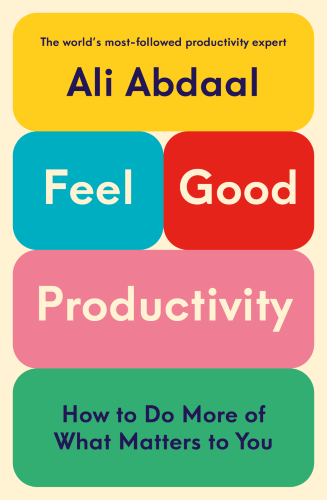
Book Cover for Feel Good Productivity by Ali Abdaal
Feel-Good Productivity: How to Do More of What Matters to You by Ali Abdaal explains how to increase your productivity without relying on discipline or motivation. Throughout the book, he includes small experiments to put the ideas into practice.
Buy Feel-Good Productivity at: Amazon | Kobo (affiliate links)
Table Of Contents
Key Takeaways from Feel-Good Productivity
- Feeling good makes us more productive.
- There’s a limit to discipline and working harder.
- Negative emotions may motivate us in the short-term, but take a toll in the long run.
- By contrast, positive emotions boost our creativity and build up our emotional and mental resources in the long-term.
- Incorporate Energisers into your life:
- Play. Finding ways to make things fun and less stressful will make you more productive.
- Power. When you feel empowered and confident, your performance increases.
- People. People can fill us with energy and motivate us to perform better.
- Overcome procrastination by Unblocking the root cause:
- Clarity. We often procrastinate when we feel uncertain about at ask. Overcome this by clarifying: why you are doing a project, what your tasks are, and when you will do them.
- Courage. Fear can also block us, triggering our brains’ ‘flight’ response. Overcome fear by labelling them, gaining perspective, and lowering the stakes.
- Get started. It’s often much harder to get started than to keep going. Overcome inertia by reducing friction, taking just a small step, and tracking your progress.
- Burnout can occur due to overexertion (too much work), depletion (not enough breaks), or misalignment (doing the wrong things). Make your efforts Sustainable by:
- Conserving. Don’t overcommit. It may be tempting to say yes to things in the future, but weigh up the opportunity costs.
- Recharging. Take quality breaks. Do creative activities that make you feel CALM (Competent, Autonomous, Liberty and Mellow). Go for a walk, maybe incorporate nature. It’s also fine to recharge mindlessly sometimes, doing whatever you want guilt-free.
- Aligning. When our behaviour is driven by external forces, instead of our values, we can burn out. Reflect on what matters most to you and experiment with ways to incorporate them into your daily life.
Detailed Summary of Feel-Good Productivity
Feeling good makes us more productive
Feel-Good Productivity isn’t about doing more at all costs, but doing more of what matters to you.
In each chapter, Abdaal suggests various experiments to help you put the ideas into practice. Not all of them will work for everyone. But even when an experiment doesn’t work, it can give you useful feedback. That’s fine. Enjoy the experimentation process. And along the way, you may well discover techniques that work better for you than any of Abdaal’s suggestions.
There’s a limit to discipline and working harder
For a long time, Abdaal’s only productivity strategy was just to work harder. It worked. But only up to a point. Once he became a junior doctor, he felt he was drowning in work, which made him neglect his health and relationships.
Positive emotions are linked to four “feel-good” hormones: endorphins, serotonin, dopamine and oxytocin. For example, curiosity gives us a dopamine hit that makes us feel good, helps us focus and remember details better. By contrast, negative emotions release stress hormones like adrenaline and cortisol. Stress hormones can motivate us in the short-term but take a toll in the long-term. [See also The Power of Full Engagement for more on these ideas.]
Positive emotions help us “broaden and build”
In the 1990s, Barbara Fredrickson came up with the “broaden-and-build” theory of positive emotions.
- Broaden. We’re more open to possibilities and new information. Various studies show that positive emotions make us more open to new ideas and improve our ability to integrate information. This all boosts our creativity.

